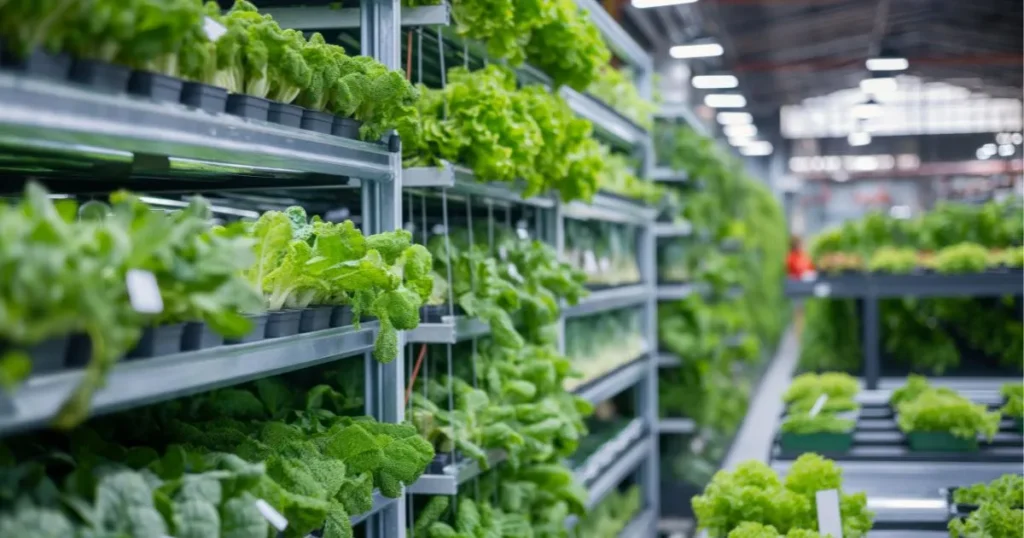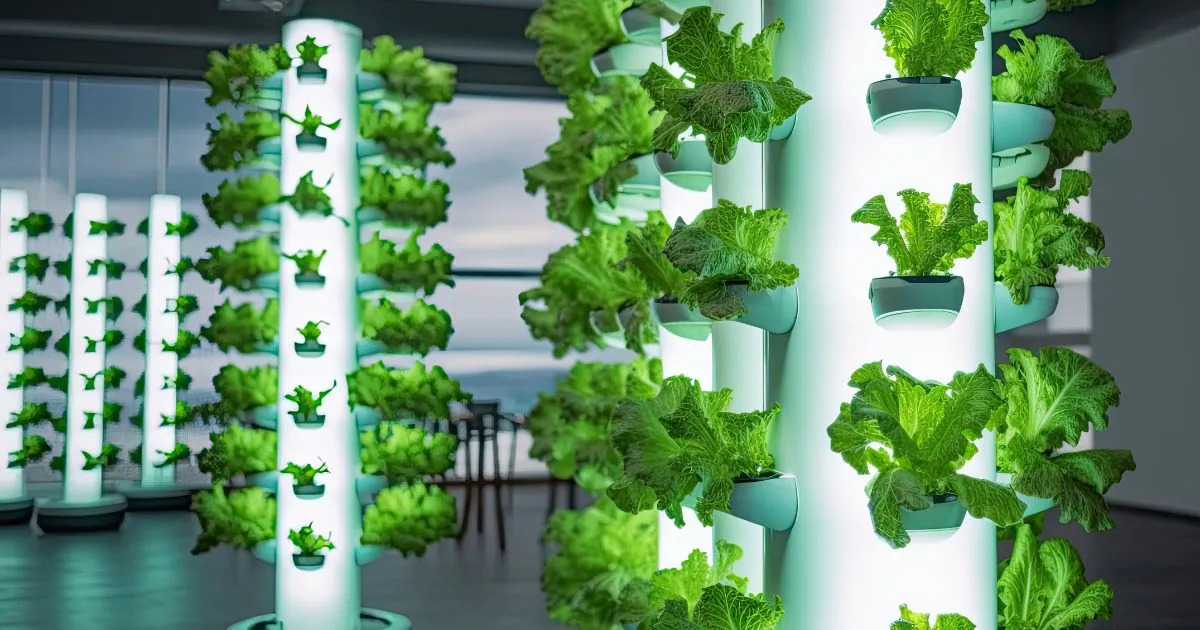Table of Contents
Indoor Vertical Farming : Revolutionizing Agriculture for a Sustainable Future
Indoor vertical farming represents a transformative innovation in agriculture, addressing challenges such as limited arable land, climate change, and the need for sustainable food production. By growing crops in vertically stacked layers within controlled environments, this method offers a promising alternative to traditional farming practices. It maximizes space utilization, minimizes water consumption, and reduces dependence on chemical pesticides, making it a key solution for feeding the world’s growing population while minimizing environmental impact.
The Concept of Indoor Vertical Farming
Indoor vertical farming involves cultivating plants indoors, often in urban settings, using vertically stacked layers or towers. This system employs advanced technologies, including LED lighting, hydroponics, aeroponics, and climate control systems, to create optimal growing conditions. Unlike traditional farming, which depends on soil and weather, vertical farms are insulated from external environmental variables, allowing year-round production and enhanced crop yields.
Key Advantages of Indoor Vertical Farming
- Efficient Land Use:
- Vertical farming requires significantly less land compared to conventional agriculture. By stacking crops vertically, farms can produce more food per square foot, making it an ideal solution for urban areas where space is limited.
- Water Conservation:
- Traditional agriculture accounts for approximately 70% of global freshwater use. Vertical farming, on the other hand, uses up to 95% less water due to its recirculating irrigation systems, which recycle water and nutrients.
- Reduction of Transportation Costs and Emissions:
- Locating farms near urban centers reduces the need for long-distance transportation, cutting greenhouse gas emissions and delivering fresher produce to consumers.
- Pesticide-Free Crops:
- Controlled environments eliminate the need for chemical pesticides, resulting in healthier, chemical-free produce.
- Resilience to Climate Change:
- Indoor vertical farms are immune to adverse weather conditions, droughts, and natural disasters, ensuring consistent food production.
- Energy Efficiency:
- Modern LED lighting systems are highly efficient and can be tailored to provide optimal wavelengths for photosynthesis, reducing energy consumption.
Technologies Driving Indoor Vertical Farming
- Hydroponics:
- Plants are grown in nutrient-rich water solutions rather than soil. This method ensures precise nutrient delivery and reduces water waste.
- Aeroponics:
- Plants are suspended in air, and nutrient-laden mist is sprayed onto their roots. Aeroponics uses even less water than hydroponics and promotes faster growth.
- LED Lighting:
- LED lights simulate natural sunlight and can be customized to specific wavelengths for optimal plant growth. Their energy efficiency and longevity make them a cornerstone of vertical farming.
- Automated Systems:
- Robotics and AI-driven systems monitor and manage temperature, humidity, CO2 levels, and nutrient delivery, enhancing precision and reducing labor costs.
- IoT and Data Analytics:
- Sensors collect real-time data, allowing farmers to make informed decisions and optimize growing conditions for maximum efficiency and yield.

Challenges Facing Indoor Vertical Farming
Despite its numerous benefits, indoor vertical farming faces several challenges:
- High Initial Investment:
- Setting up a vertical farm requires significant capital for infrastructure, technology, and equipment.
- Energy Consumption:
- Although LED technology is efficient, energy use remains a significant cost. Transitioning to renewable energy sources can mitigate this issue.
- Limited Crop Variety:
- Currently, vertical farming is best suited for leafy greens, herbs, and small fruits. Expanding to staple crops like wheat or rice remains a challenge.
- Technical Expertise:
- Operating and maintaining advanced systems requires specialized knowledge and skills, which can be a barrier for widespread adoption.
The Future of Indoor Vertical Farming
The future of indoor vertical farming is bright, with ongoing advancements addressing current limitations. Innovations in renewable energy integration, automation, and genetic engineering of crops are set to further enhance the viability of vertical farming. Additionally, partnerships between technology companies, agricultural experts, and governments are fostering investments and research in the field.
Case Studies and Real-World Applications
- AeroFarms (USA):
- AeroFarms operates one of the largest indoor vertical farms, using aeroponic technology to grow pesticide-free leafy greens. Their facility in Newark, New Jersey, produces up to 390 times more yield per square foot than traditional farming.
- Plantagon (Sweden):
- Plantagon integrates vertical farming with urban architecture, creating “agrihoods” where residents can access fresh produce grown on-site. This approach combines sustainability with urban living.
- Sky Greens (Singapore):
- Sky Greens uses a unique rotating vertical farming system, enabling efficient sunlight exposure and water recycling. It addresses Singapore’s land scarcity while ensuring food security.
FAQ
What crops can be grown in indoor vertical farms?
Indoor vertical farms are ideal for growing leafy greens, herbs, microgreens, and some fruits like strawberries. Research is ongoing to expand this to staple crops like wheat and rice.
Is vertical farming environmentally sustainable ?
Yes, vertical farming is highly sustainable. It uses less water, reduces the need for pesticides, and minimizes transportation emissions by growing food closer to urban centers.
How much does it cost to set up a vertical farm ?
The cost varies based on size, technology, and location. Initial investments can range from tens of thousands to several million dollars for large-scale operations.
Does vertical farming require soil?
No, vertical farming primarily uses soilless methods like hydroponics and aeroponics, relying on nutrient-rich water or mist to nourish plants.
How does vertical farming contribute to food security?
By providing a consistent and controlled environment for food production, vertical farming reduces dependence on unpredictable weather and ensures a steady supply of fresh produce year-round.
What are the energy requirements for vertical farming?
Energy consumption is primarily for LED lighting and climate control systems. Renewable energy sources are increasingly being integrated to offset costs and reduce carbon footprints.
Can vertical farming be profitable?
Yes, while the initial investment is high, vertical farms can be profitable due to higher yields, reduced water use, and the premium price of fresh, local, pesticide-free produce.
Are there any health benefits to produce grown in vertical farms?
Produce from vertical farms is often fresher and free from chemical pesticides, which can contribute to better health and taste.
Can vertical farming solve global hunger?
Vertical farming has the potential to significantly contribute to food security, especially in urban areas. However, it should be part of a broader strategy that includes traditional agriculture and policy support.
Where are vertical farms most beneficial?
Vertical farms are most beneficial in urban areas with limited arable land, regions with extreme climates, and places striving to reduce food transportation emissions.
Conclusion
Indoor vertical farming is a groundbreaking approach to modern agriculture, offering solutions to some of the most pressing challenges of our time. While obstacles remain, technological advancements and growing interest in sustainable practices are propelling the industry forward. As the world grapples with climate change and population growth, indoor vertical farming stands out as a beacon of hope, promising a future where food production is efficient, resilient, and environmentally friendly.

